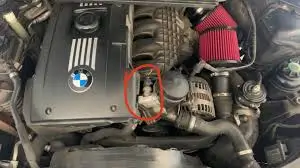Owning a BMW is a thrilling experience, thanks to its unparalleled performance, luxury, and cutting-edge technology. But even the most sophisticated BMW engines are prone to issues like a vacuum leak. While it may seem like a minor problem, BMW vacuum leak symptoms can significantly impact your vehicle’s performance if left unaddressed.
This comprehensive guide will take you through the essential information about BMW vacuum leaks, the symptoms that signal an issue, how to diagnose it, and how to resolve it effectively. Whether you’re a seasoned BMW owner or new to the world of luxury cars, understanding these symptoms will help you ensure your BMW performs optimally.
What is a Vacuum Leak in a BMW?
A vacuum leak occurs when extra air enters the engine through cracks in hoses, damaged gaskets, or disconnections within the vacuum system. This influx of air disrupts the fuel-air mixture in the engine, causing the engine to run lean. Running lean means the engine is getting more air and less fuel, which compromises its performance.
Key Concepts to Understand:
Vacuum System: A network of hoses and gaskets responsible for managing various components of your BMW engine via vacuum pressure.
Mass Air Flow (MAF) Sensor: Measures the air entering the engine, helping the engine control unit (ECU) calculate the appropriate amount of fuel.
Powertrain Control Module (PCM): The brain of the engine, responsible for interpreting data from sensors and optimizing engine performance.

BMW Vacuum Leak Symptoms You Should know
Spotting BMW vacuum leak symptoms early can help prevent costly repairs and ensure your car stays in top shape. Here are the most common signs of a vacuum leak in your BMW:
Rough Idle: If your BMW’s engine is idling roughly or the RPM is higher than usual, it’s often due to a vacuum leak. The engine struggles to maintain the correct air-fuel ratio, leading to poor idling performance.
Check Engine Light: A vacuum leak can trigger the check engine light. When the engine control unit (ECU) detects an imbalance in the air/fuel mixture, it generates a trouble code, such as P0171 or P0174. This is one of the most common BMW vacuum leak symptoms.
High-Pitched Noise from the Engine: A distinctive high-pitched hissing sound often accompanies a vacuum leak. This sound occurs when air is being drawn into the engine through a damaged hose or gasket. It’s one of the easiest BMW vacuum leak symptoms to identify.
Misfires or Backfires: If your engine starts misfiring or backfiring, it could be caused by a vacuum leak. A vacuum leak can cause the air/fuel mixture to become too lean, which leads to improper ignition and misfires in the engine cylinders.
Rough or Slow Acceleration: A vacuum leak can make it difficult for your BMW to accelerate smoothly. The engine may feel sluggish or slow to respond when you press the throttle, as it’s not receiving the correct amount of fuel.
Cracked or Disconnected Vacuum Hoses: Over time, vacuum hoses can crack or become disconnected. This is one of the most common causes of BMW vacuum leak symptoms, especially in older models.
Stalling or Starting Problems: A vacuum leak can cause stalling or difficulty starting your BMW. This happens because the engine’s air-to-fuel ratio is off, making it harder for the engine to start and run smoothly.
Why You Should Address BMW Vacuum Leak Symptoms
Even though a vacuum leak might seem like a minor issue at first, ignoring the BMW vacuum leak symptoms can cause significant damage to your engine over time. Here’s why it’s important to act quickly:
Reduced Engine Efficiency: A vacuum leak makes the engine run less efficiently by throwing off the air-fuel ratio. As a result, your BMW may lose power and fail to perform optimally.
Increased Emissions: When the air-fuel mixture is not balanced, your BMW will emit more pollutants, which could lead to your car failing emissions tests.
Engine Damage: Continuous misfires, backfires, and other performance issues caused by a vacuum leak can lead to serious engine wear, requiring costly repairs or even replacements.
By addressing BMW vacuum leak symptoms as soon as they appear, you can prevent damage and maintain your vehicle’s performance.
Common Causes of BMW Vacuum Leaks
Several factors can lead to a BMW vacuum leak. Identifying the root cause is essential for resolving the issue efficiently. Here are the most common causes of vacuum leaks in a BMW:
Damaged or Cracked Vacuum Hoses: Vacuum hoses are prone to cracking, wearing out, or becoming disconnected over time. This is the most common cause of a BMW vacuum leak.
Leaking Intake Manifold Gasket: The intake manifold gasket seals the intake manifold to the engine block. If this gasket deteriorates, it can cause a vacuum leak, allowing extra air to enter the engine.
Faulty Throttle Body Gasket: A worn or damaged throttle body gasket can result in a vacuum leak around the throttle body, disrupting the engine’s air-fuel mixture.
Faulty Brake Booster: The brake booster relies on vacuum pressure to assist with braking. A failing brake booster can leak vacuum pressure into the engine, causing a vacuum leak.
Worn PCV (Positive Crankcase Ventilation) Valve: A malfunctioning PCV valve can allow air to enter the engine, leading to a BMW vacuum leak.
Exhaust Gas Recirculation (EGR) Valve Failure: If the EGR valve fails, it can cause a vacuum leak by allowing unwanted air to enter the engine, affecting performance.
Damaged Intake Snorkel: The intake snorkel helps direct airflow into the engine. If it’s cracked or disconnected, it can result in a vacuum leak.
How to Find a BMW Vacuum Leak
Identifying the exact location of a vacuum leak is crucial for effective repair. Here are several methods you can use to find a vacuum leak in your BMW:
Visual Inspection: Start by visually inspecting all vacuum hoses and gaskets. Look for cracks, wear, or disconnected hoses. Pay special attention to the intake manifold, throttle body, and brake booster connections.
Spray Method (Flammable Fluids): One common method for detecting BMW vacuum leak symptoms is using flammable fluids like brake cleaner or carburetor cleaner. Spray around areas where you suspect a leak, such as the intake manifold gasket or vacuum hoses. If the engine RPM increases when the fluid is drawn into the intake, you’ve likely found the source of the vacuum leak.
Caution: This method is risky and should only be done with great care. Always perform this test in a well-ventilated area and away from any open flames.
Smoke Testing: A more effective and safer way to find a vacuum leak is using a smoke machine. This tool injects smoke into the engine’s vacuum system, and any leaks will allow the smoke to escape, clearly identifying the source of the leak.
Listening for Sounds: If you hear a high-pitched hissing sound, it’s a clear sign of a vacuum leak. Listen carefully around the intake manifold, vacuum lines, and other critical areas.
Final thoughts
A BMW vacuum leak can lead to various symptoms, from rough idling and poor acceleration to engine misfires and stalling. By understanding these BMW vacuum leak symptoms and addressing them early, you can keep your BMW running smoothly and prevent costly repairs down the road. Whether you choose to tackle the repairs yourself or seek professional assistance, fixing a BMW vacuum leak is crucial for maintaining your vehicle’s performance and longevity.
By regularly inspecting the vacuum system, replacing damaged hoses or gaskets, and taking care of any issues promptly, you’ll ensure that your BMW vacuum leak symptoms are kept under control and your car continues to perform at its best.
